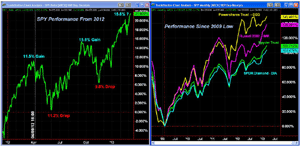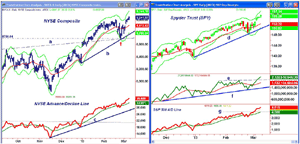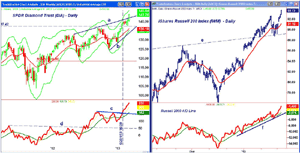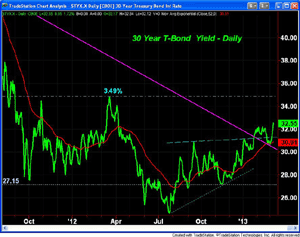Stronger-than-expected employment numbers fueled the sixth straight day of gains in the stock market, and as euphoria starts to creep in, MoneyShow’s Tom Aspray counsels investors to be patient, concentrate on risk rather than reward, and wait for better opportunities in the months ahead.
It has been quite a week for the stock market as the Dow made a series of new all-time highs and financial reporters were tripping over each other to find new slants on the stock market’s surprising strength.
There are still some skeptics voicing their opinions, but there has been quite a change in sentiment since Christmas when headlines like these seemed to dominate the news.
Consumer Confidence Tumbles Over Fiscal Cliff; Economy Next?
So Much For 'Happy Holidays'
Time For A Few More Bear Call Spreads
The current market sentiment is a bit too euphoric and the great numbers on unemployment Friday gave most even more reasons to be bullish. Both the weekly and daily charts of my key technical indicators (see below ) are positive, and while I expect more new market highs in the months ahead, I do not think it will be easy.
What I am looking for in March is what I call a “vegematic market,” which was a term I coined in the 1980s on FNN, a precursor to CNBC. It is, of course, based on the popular Ronco device that “slices and dices” everything. If I am correct, a choppy market this month this will make it difficult for those who invest in index-based products while stock pickers who concentrate on entry levels and risk should do much better.
The seasonal analysis of the S&P 500 using data going back to 1937 supports this view. This chart shows that the typical seasonal tendency is for a high around March 6 (in red), then a low around March 14 (in green) followed by another high on the 21st with a low at the end of the month. I would be surprised if we didn’t see at least one-two sharp down days this month.
Most investors who are not in the market are wondering whether it is too late to buy or if they are long, should they be selling. Countless articles focus on the popular, but not really accurate view that the public always buys at market tops and sells at market bottoms.
NEXT PAGE: Stocks & Tom’s Outlook
|pagebreak|
In my mid-December column Stuff Those Stockings with Stocks, I featured a chart showing that stock ownership, despite the rally from the March 2009 lows, was still well below historically high levels (see chart). Though the public’s exposure to stocks has increased in the past few month we are not close to the sentiment extremes that I observed in 2000.
One also should not forget what happened in 2012 as this updated chart shows the several wide swings in the SPY that occurred in 2012. The SPY is now up over 15% since the November 2012 lows and is already close to the yearly double-digit gain that I discussed at the end of the year.
Since most of the upside targets from Wall Street strategists have already been reached or exceeded, I expect to see some upward revisions in the coming weeks, but don’t get too excited.
Even though the technology sector has been out of favor for the past few months, it has been the star performer since the 2009 lows as it is up over 149% followed by the small cap Russell 2000 IWM.
Both have clearly done better than the S&P 500, but of course, they are more volatile and therefore have more risk. The improvement in the relative performance of the Dow tracking SPDR Diamond Trust (DIA) in the past few weeks suggests it may overtake SPY in the coming weeks.
Last week was a pretty quiet in the Eurozone, and as expected, the market leading DAX Index did complete its corrective pattern, but is still below its all time highs from 2007. I do expect developments in the Eurozone to trigger some stock market selling in the coming months.
In addition to the jobs data last week the ISM Non-Manufacturing Index rose to 56, which suggests that the economy is growing nicely and will continue to do so. The chart shows that is well above the key level of 50 and a move above the November high of 60.9 would be very positive. The generally volatile factory orders came in weaker than expected.
This week the calendar is pretty light with retail sales, import, and export prices, as well as business inventories on Wednesday. Thursday, in addition to the jobless claims, we have the Producer Price Index. The Consumer Price Index comes out on Friday along with the Empire State Manufacturing survey as well as industrial production.
NEXT PAGE: What to Watch
|pagebreak|
What to Watch
The focus last week was on the Dow Industrials, which gained over 250 points and many of the oversold Dow stocks did quite well. Stocks like International Business Machines (IBM) were up well over 3% for the week. In fact there were quite a few other stocks that I felt comfortable recommending last week.
In last week’s column, I concluded that you should be looking to buy not sell. Even though I think that there will be choppy trading in the major averages this month, I expect many stocks will buck the trend. Many remember that the S&P 500 was flat in 2011 as the purple line on the chart indicates. On the other hand McDonald’s Corp. (MCD) rose from $76.60 to close the year at $100.33 as the chart shows its strong uptrend.
The best approach to picking stocks I think will be to target stocks that have positive weekly and monthly technical patterns but have undergone retracements. I discussed in detail the methods that I use in last week’s trading lesson, which were presented in a manner that hopefully will allow you to follow it on your own.
The individual investors did not get much more positive last week as the bullish% rose to 31% up from 28.4% the following week with 38.5% now bearish. Even the financial newsletter writers apparently are not convinced as the bullish percentage dropped to 44.2% last week down from 46.3%. The bearish percentage is quite low at 21%, which means that many are just looking for a correction.
The daily chart of the NYSE Composite shows the test of the daily starc- band on February 26 with the higher close. The up gap opening last Tuesday completed the correction and the starc+ band is now at 9144.
The next major resistance from 2008 is in the 9,400 area with additional at 9,724. The all-time high from October 2007 stands at 10,311. The NYSE Advance/Decline reversed back above its WMA at the end of February and made a series of new highs last week. It has continued to lead prices higher.
The 20-day EMA is at 8912 with key support now in the 8700 area.
S&P 500
The Spyder Trust (SPY) also came close to its daily starc- band before resuming its overall up trend. Another new weekly closing high makes the next major target at $157.42 with the starc+ band at $157.14.
The daily on-balance volume (OBV) broke through its recent highs (line e) last week and confirmed the new price highs. The OBV is well above its WMA and the long-term support at line f.
The S&P 500 A/D line was able to breakout to new highs (line g) before the end of the month and it is also leading prices higher. It closed the week at new highs. There is first support now for SPY at $152.90-$153.60 with the 20 day EMA at $152.32.
NEXT PAGE: Sector Focus and Tom’s Outlook
|pagebreak|
Dow Industrials
The SPDR Diamond Trust (DIA) surged through its long-term resistance at line a last week and closed the week just slightly below its daily starc+ band at $144.89. The weekly starc+ band is now at $145.91.
There is first weekly support now in the $140 area with more important at $137.42.
The weekly Dow Industrials A/D line moved above the major resistance last summer (line d), which confirmed the positive signals from the daily A/D lines in early June. In the last half of 2012, the A/D line formed a trading range (line c), which was completed on February 1.
Russell 2000
The iShares Russell 2000 Index (IWM) gained close to 3% last week closing again at new all-time highs. I recently responded to an article that warned investors not to be in small-cap stocks, and hopefully, most did not follow their advice as the technical outlook continues to look strong.
For this week, the starc+ band is at $95.84, with the quarterly R2 resistance at $97.69. The Russell 2000 A/D line has made a series of new highs over the past week and has continued to act stronger than prices. If it continues to rise this sharply, it could get overextended this week.
Nasdaq-100
The PowerShares QQQ Trust (QQQ), after dropping just below the quarterly pivot support at $66.10, rebounded impressively this week as it was up almost 2%. The resistance we have been watching at $68.35 was finally overcome on a closing basis.
The next major resistance is at $69.80 and $70.58, which was last September’s high.
It will be important that the support in the $67.70-$68 area hold on any pullback.
The Nasdaq-100 A/D line (not shown) has confirmed the price action as it is now above both the September and the June highs. It is still well below the highs made in March of 2012.
Sector Focus
This week for a change the SPDR Diamond Trust (DIA) made a new all-time high along with the iShares Dow Jones Transportation (IYT).
In January, some were concerned that the failure of the Dow Industrials to make a new highs with the Transports meant that stocks could not go higher. The technical evidence discussed in the article indicated that the Transports were quite strong, and that it showed no signs of topping out.
IYT was up close to 3% last week as the 3.8% pullback to the $103.03 level on February 26 was all the correction this market needed. It still looks strong technically.
NEXT PAGE: Commodities & Tom’s Outlook
|pagebreak|
The Select Sector SPDR Financials (XLF), Select Sector SPDR Energy (XLE), Select Sector SPDR Consumer Discretionary (XLY), and Select Sector SPDR Materials (XLB) were the best performers last week as they were up 3% or more.
The daily chart of the Select Sector SPDR Financials (XLF) made convincing new highs last week after briefly breaking its uptrend (line a) on the correction. This is a good example of why breaking a trend line is not always negative as XLF held well above the 38.2% support on the correction.
The weekly chart of the Select Sector SPDR Materials (XLB) shows that it broke the weekly downtrend, line b, in early January. On the February correction, it retested the downtrend before turning higher. It is still below its early 2013 highs.
The Select Sector SPDR Health Care (XLV), Select Sector SPDR Consumer Discretionary (XLY), and Select Sector SPDR Industrials (XLI) also made new highs last week.
Crude Oil
The May crude oil contract appears to be bottoming out as it dropped to monthly pivot support at $89.77 before turning higher There is next strong resistance in the $94-$95 area. There are a few energy stocks that have quite nice charts, and I recommended two last week.
Interest Rates
The yield on both the 10-year T-Note and the 30-year T-Bond closed at their highest level in almost a year. The daily chart of the T-Bond yield shows that it retested its former downtrend (line a) and its 20-day EMA before moving sharply higher. This may mean that the flow out of bonds and into stocks has picked up, which would be a very bullish development.
Precious Metals
Precious metals stabilized last week, and while silver looks the best technically, it needs one strong up day to confirm that a bottom is in place. Gold still is lagging for now, and I would stay on the sidelines.
The Week Ahead
The bullish action last week is likely to spur more movement into stocks, but for those who are looking at an index tracking fund, I would stick with the dollar cost averaging approach that I discussed in January.
I recommended ten stocks and ETFs last week and some of the buy levels were hit. I would continue to work these buy levels, but may adjust a few next week. For those who have not been in the market, I would recommend concentrating on high-yielding large-cap stocks.
I would not recommend getting into something like the Spyder Trust (SPY) or SPDR Diamond Trust (DIA) at this time and would only consider them if we get a decent pullback. Try to be patient and concentrate on the risk rather than the reward as I think there will be some good opportunities in the months ahead.
Don't forget to read Tom's latest Trading Lesson, Finding High-Probability Entry Levels.



















